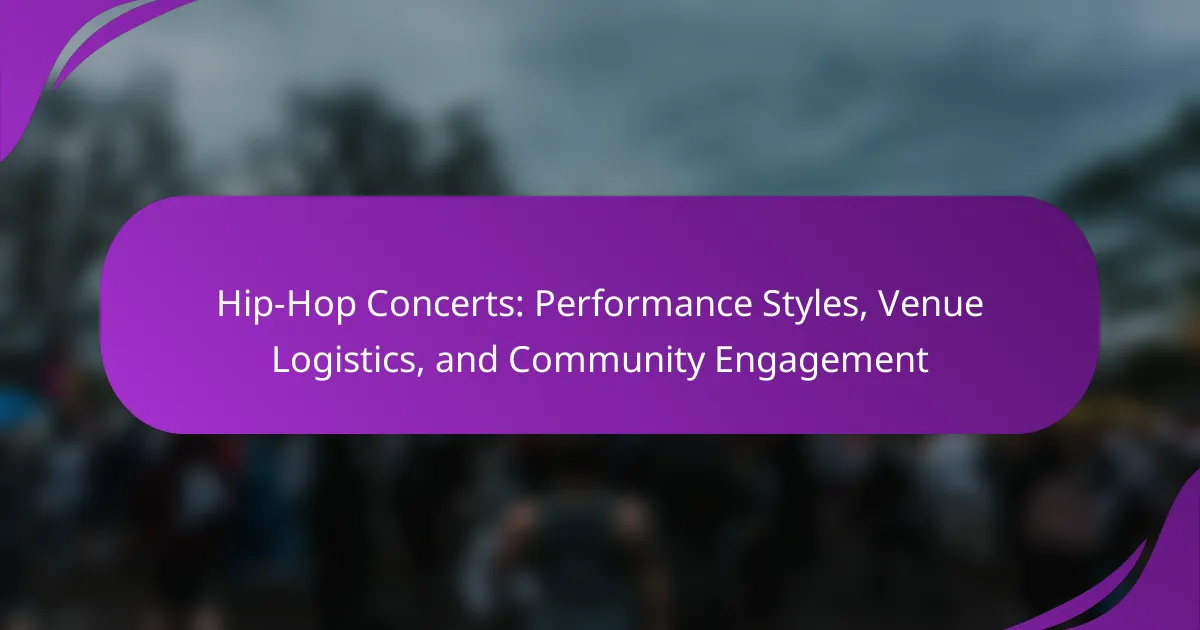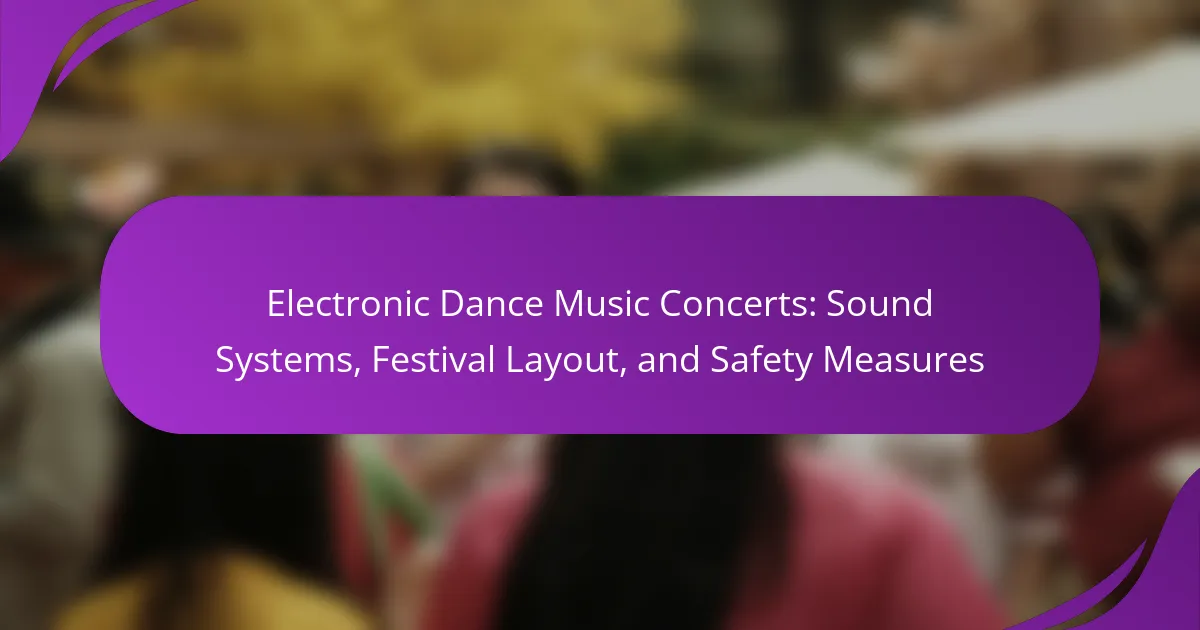Charity concerts are live music events designed to raise funds for various charitable causes, featuring performances from a range of artists to draw in attendees. The proceeds from these events typically support specific charities or community initiatives, while also promoting awareness of social issues. Organizers select beneficiaries based on community needs and the alignment of the charity’s mission with local concerns. Successful charity concerts require clear goals, suitable venues, strategic partnerships, and effective promotion to maximize engagement and donations. Key practices for organizing these events include evaluating impact, efficient resource management, and gathering feedback to assess success.
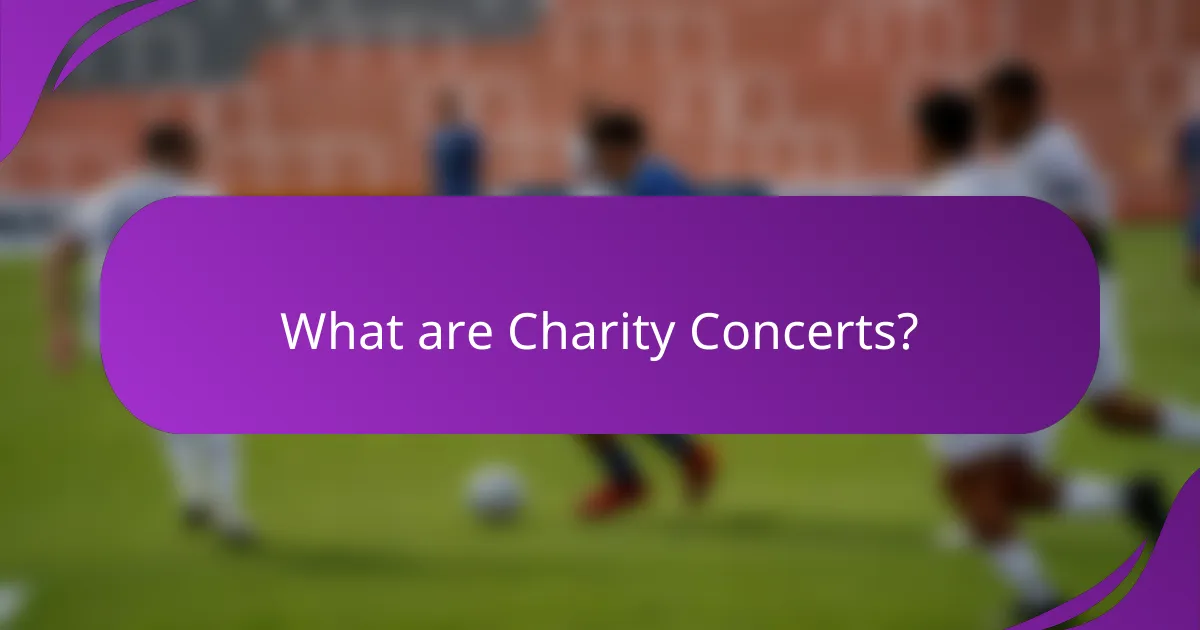
What are Charity Concerts?
Charity concerts are live music events organized to raise funds for charitable causes. These concerts feature various artists performing to attract attendees. The proceeds from ticket sales, merchandise, and donations typically benefit a specific charity or community initiative. Charity concerts can vary in scale from small local events to large festivals with well-known performers. They often promote awareness of social issues alongside fundraising efforts. Historical examples include Live Aid in 1985, which raised millions for famine relief in Ethiopia. Such events demonstrate the power of music to unite people for a common cause.
How do Charity Concerts serve their purpose?
Charity concerts serve their purpose by raising funds and awareness for specific causes. They attract large audiences through popular artists and engaging performances. Ticket sales generate revenue that directly supports charitable organizations. Additionally, these events create a platform for advocacy and education about the cause. They often feature stories from beneficiaries, enhancing emotional connections. Statistics show that successful charity concerts can raise millions for various initiatives. For example, the 2010 Hope for Haiti Now concert raised over $60 million for earthquake relief. Overall, charity concerts effectively combine entertainment with philanthropy to achieve their goals.
What causes are typically supported by Charity Concerts?
Charity concerts typically support causes such as health care, education, disaster relief, and social justice. Health care causes often include funding for medical research or support for specific diseases. Education initiatives may focus on providing scholarships or resources for underprivileged students. Disaster relief efforts aim to raise funds for communities affected by natural disasters. Social justice causes often advocate for human rights and equality. These concerts mobilize artists and audiences to contribute to meaningful social change. Historical examples include Live Aid, which raised funds for famine relief in Ethiopia.
Why are Charity Concerts effective in raising awareness?
Charity concerts are effective in raising awareness because they engage audiences through music and entertainment. The emotional connection created by live performances enhances the impact of the cause. Attendees often feel a sense of community and shared purpose. This collective experience can motivate individuals to learn more about the issues presented. Additionally, the visibility of these events can attract media coverage. Media exposure amplifies the message beyond the concert attendees. Statistics show that events with celebrity involvement can significantly increase awareness. For example, the 2010 Hope for Haiti Now concert raised over $60 million and brought attention to the earthquake’s aftermath.
What are the key elements of organizing a Charity Concert?
The key elements of organizing a charity concert include selecting a cause, securing a venue, and booking performers. The cause should resonate with potential attendees and sponsors. Choosing an appropriate venue involves considering capacity, accessibility, and facilities. Booking performers requires understanding their availability and appeal to the target audience. Additionally, promoting the event through various channels is crucial for attendance. Collaborating with sponsors can provide financial support and resources. Finally, planning logistics like ticket sales, sound equipment, and security is essential for a successful event. Each element contributes to achieving the concert’s fundraising goals effectively.
How do you select the right venue for a Charity Concert?
To select the right venue for a charity concert, consider capacity, location, and accessibility. The venue should accommodate the expected audience size comfortably. A central location increases attendance and convenience for guests. Accessibility features, such as ramps and parking, ensure inclusivity for all attendees. Evaluate the venue’s acoustics and technical capabilities for sound and lighting. Availability on the desired date is crucial for scheduling. Additionally, compare rental costs to your budget to ensure financial feasibility. Research venues with experience hosting similar events to gauge their suitability and reliability.
What role do artists and performers play in Charity Concerts?
Artists and performers are central to charity concerts. They draw audiences and create an engaging atmosphere. Their performances raise awareness for the cause being supported. Additionally, they often encourage donations through their influence. Many artists use their platforms to promote social issues. For instance, high-profile musicians can attract media attention. This amplifies the reach of the fundraising efforts. Ultimately, their participation can significantly increase the funds raised for charity.
What strategies can enhance the success of a Charity Concert?
Effective strategies to enhance the success of a charity concert include thorough planning, targeted marketing, and artist selection. Planning involves setting clear goals and timelines. This ensures all aspects of the event are organized efficiently. Targeted marketing reaches the right audience. Utilizing social media and local press can increase visibility.
Artist selection is crucial for drawing attendees. Popular or local artists can attract larger crowds. Collaborating with sponsors can also provide financial support and increase credibility. Engaging the community fosters a sense of ownership. Involving local businesses can create partnerships that benefit both parties.
Logistics must be meticulously managed. This includes venue selection, ticketing systems, and sound equipment. Ensuring a smooth experience for attendees enhances satisfaction. Feedback collection post-event can provide insights for future improvements. These strategies collectively contribute to a successful charity concert.
How can social media be utilized for promoting Charity Concerts?
Social media can effectively promote charity concerts by reaching a wide audience quickly. Platforms like Facebook and Instagram allow for event creation and sharing. Engaging content, such as videos and images of past concerts, can attract attention. Hashtags related to the event can increase visibility and engagement. Influencers can be partnered with to amplify the message. Live updates during the event can maintain interest and encourage donations. According to a 2021 report by Nonprofit Tech for Good, 79% of nonprofits use social media for fundraising efforts. This highlights its effectiveness in promoting charitable initiatives.
What are effective fundraising techniques during a Charity Concert?
Effective fundraising techniques during a charity concert include ticket sales, sponsorships, and auctions. Ticket sales generate immediate revenue. Offering tiered pricing can increase participation. Sponsorships provide financial support and brand visibility. Collaborating with local businesses can enhance community engagement. Auctions can include donated items or experiences, driving competition among attendees. Live appeals during the event can encourage direct donations. Utilizing social media for promotion can expand reach and attract more attendees. These techniques have been successfully implemented in various charity events, demonstrating their effectiveness in raising funds.
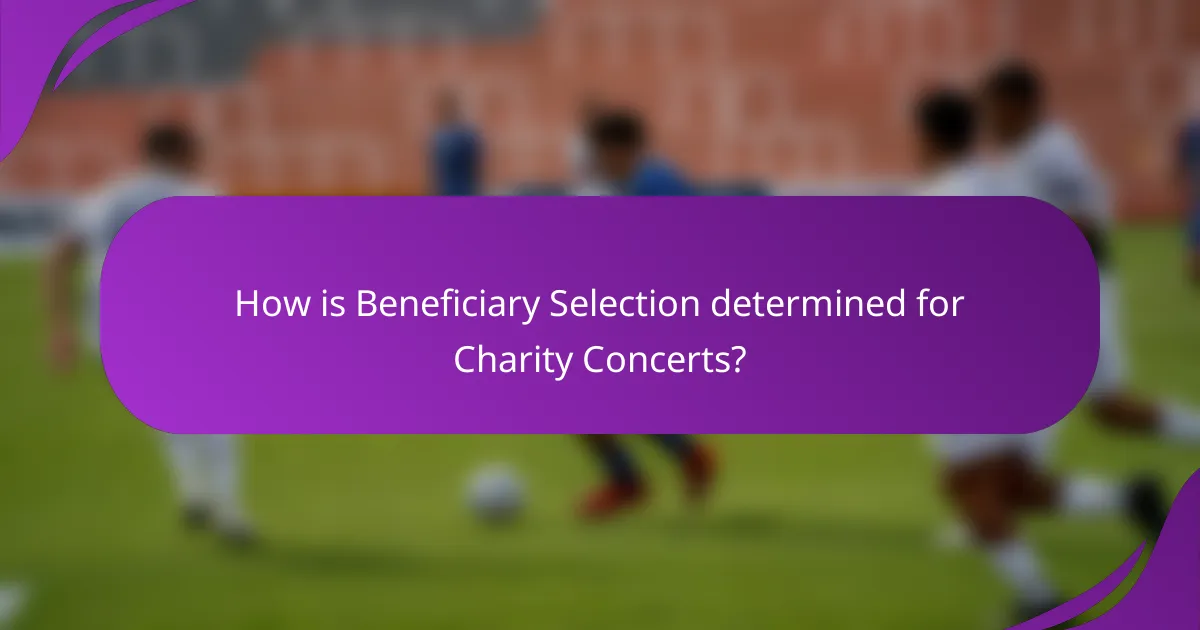
How is Beneficiary Selection determined for Charity Concerts?
Beneficiary selection for charity concerts is determined through a combination of community needs assessment and organizational mission alignment. Event organizers typically evaluate local issues to identify beneficiaries that address pressing social or health concerns. They may also consider the impact of the charity’s work and its reputation within the community. Additionally, partnerships with established charities can influence selections based on their track record and outreach capabilities. Research shows that successful charity events often align with beneficiaries that resonate with the audience’s values. This alignment can enhance attendee engagement and increase donations, ultimately benefiting the selected cause.
What criteria are used to select beneficiaries for Charity Concerts?
Criteria for selecting beneficiaries for charity concerts include alignment with the concert’s mission, financial need, and community impact. Organizations often prioritize causes that resonate with the audience. They assess the beneficiary’s transparency and accountability in fund management. Beneficiaries are typically local to foster community support. The potential for outreach and awareness generation is also considered. Finally, previous successful collaborations may influence selection. These criteria ensure that the funds raised have a meaningful impact.
How do organizers ensure transparency in beneficiary selection?
Organizers ensure transparency in beneficiary selection through clear criteria and open communication. They establish specific guidelines for eligibility, ensuring that all potential beneficiaries understand the requirements. Publicly sharing these criteria fosters trust within the community. Additionally, organizers often involve stakeholders in the selection process. This can include community members or experts who provide input on beneficiaries. Regular updates about the selection process are communicated to the public. This openness helps to maintain accountability. Many organizers also publish the final list of selected beneficiaries. This practice allows for public scrutiny and reinforces the integrity of the selection process.
What are the common challenges faced in beneficiary selection?
Common challenges in beneficiary selection include identifying genuine needs, ensuring transparency, and avoiding bias. Identifying genuine needs can be difficult due to varying community priorities. Transparency issues arise when stakeholders question the selection criteria. Bias can occur if personal relationships influence decisions. Additionally, limited resources may restrict the number of beneficiaries. Inconsistent data on potential beneficiaries can lead to misinformed choices. Finally, community engagement is vital but often challenging to achieve effectively.
How do different types of beneficiaries impact Charity Concerts?
Different types of beneficiaries significantly influence charity concerts. Beneficiaries can be individuals, communities, or specific causes. Each type shapes the concert’s messaging and audience engagement. For instance, concerts supporting children’s health often attract family-oriented audiences. In contrast, events for environmental causes may appeal to eco-conscious attendees.
The choice of beneficiary also affects sponsorship opportunities. Corporations prefer to align with causes that resonate with their brand values. This alignment can lead to increased funding and promotional support. Additionally, the beneficiary’s reputation impacts ticket sales and public interest. Well-known beneficiaries often draw larger crowds, enhancing fundraising potential.
Ultimately, the beneficiary type dictates concert themes, marketing strategies, and partnership opportunities. This dynamic can either amplify or hinder the event’s success.
What are the differences between local and international beneficiaries?
Local beneficiaries are individuals or organizations that benefit from charitable efforts within a specific geographic area. They often include community members, local nonprofits, or regional causes. International beneficiaries are those who receive support from charitable initiatives that extend beyond national borders. They can include global organizations or individuals facing challenges in different countries.
The primary difference lies in the geographic focus of the beneficiaries. Local beneficiaries typically address community-specific issues, such as homelessness or education. In contrast, international beneficiaries often tackle global challenges like poverty or disaster relief.
Charity concerts may prioritize local beneficiaries to foster community engagement. Alternatively, they may aim for international beneficiaries to raise awareness about global issues. The choice impacts the concert’s theme, audience, and outreach strategies.
How does the choice of beneficiary affect audience engagement?
The choice of beneficiary significantly affects audience engagement. When audiences relate to the beneficiary, they are more likely to participate. Emotional connections to the cause can drive attendance and donations. For instance, local beneficiaries often evoke stronger community support. Research shows that events supporting familiar causes see higher engagement rates. A study by the Nonprofit Marketing Guide found that campaigns with relatable beneficiaries raised 30% more funds. This illustrates the direct correlation between beneficiary choice and audience involvement.
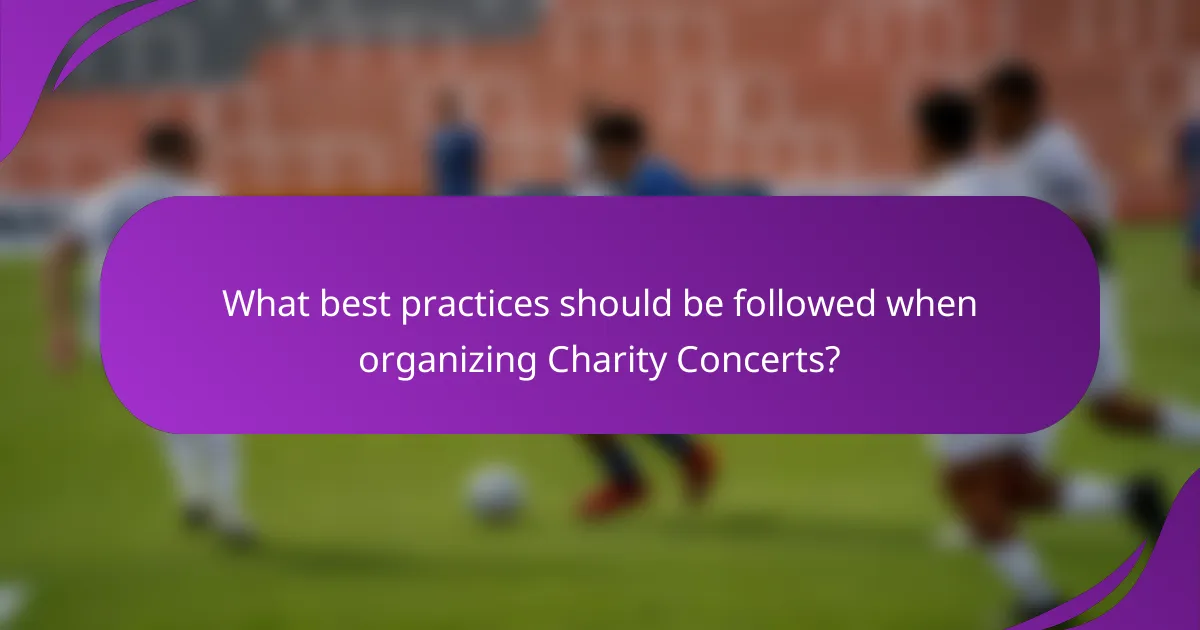
What best practices should be followed when organizing Charity Concerts?
To organize successful charity concerts, establish clear goals and objectives. Define the purpose of the concert, such as raising funds or awareness. Select a suitable venue that accommodates the expected audience size. Collaborate with artists and performers who align with the cause. Promote the event through various channels, including social media and local media outlets. Ensure effective ticketing and pricing strategies to maximize attendance and donations. Engage volunteers for support in logistics and event management. Finally, evaluate the event’s success through feedback and financial analysis. These practices enhance the concert’s impact and ensure efficient resource use.
How can organizers effectively measure the impact of a Charity Concert?
Organizers can effectively measure the impact of a charity concert through various methods. They can analyze the total funds raised during the event. This financial metric provides a direct indication of the concert’s success. Additionally, organizers can survey attendees to gauge their satisfaction and engagement. Feedback can reveal how well the concert met its goals. Tracking social media engagement pre-and post-event can also indicate the concert’s reach and influence. Metrics such as shares, likes, and comments reflect audience interaction. Furthermore, monitoring the number of new donors acquired can show the concert’s effectiveness in expanding the donor base. Finally, evaluating the awareness generated for the cause can be assessed through media coverage and public response. Collectively, these methods provide a comprehensive overview of the charity concert’s impact.
What tools can be used for tracking donations and engagement?
Common tools for tracking donations and engagement include software like DonorPerfect, Bloomerang, and Classy. DonorPerfect offers comprehensive donor management features. Bloomerang focuses on donor retention analytics. Classy provides fundraising event management tools. Other options include Salesforce for Nonprofits and Network for Good. These platforms help organizations analyze donor behavior and engagement levels. They also allow for tracking donation trends over time. Using these tools can enhance fundraising strategies and improve donor relationships.
How can feedback from attendees improve future Charity Concerts?
Feedback from attendees can significantly enhance future Charity Concerts. It provides insights into attendee experiences and preferences. Understanding what attendees enjoyed helps organizers replicate successful elements. Identifying areas for improvement can lead to better planning and execution. For example, feedback might reveal preferred music genres or effective promotional strategies. This information can guide artist selection and marketing efforts. Additionally, attendee feedback can highlight logistical issues, such as venue accessibility or seating arrangements. Addressing these concerns can improve overall attendee satisfaction and increase future attendance. Ultimately, incorporating attendee feedback fosters a more engaging and successful charity concert experience.
What tips can help ensure a successful Charity Concert experience?
To ensure a successful charity concert experience, careful planning is essential. Start by selecting a suitable venue that can accommodate your expected audience. Ensure the venue has necessary facilities like sound equipment and accessibility options. Collaborate with local artists to attract a diverse audience. Promote the event through social media, flyers, and community partnerships to increase visibility. Set clear fundraising goals to measure success. Provide engaging activities during the concert to enhance the experience. Lastly, gather feedback post-event to improve future concerts. These strategies have been shown to increase attendance and fundraising outcomes in previous charity events.
How important is collaboration with local businesses and sponsors?
Collaboration with local businesses and sponsors is crucial for charity concerts. It enhances funding opportunities and resource availability. Businesses often provide financial support, which can significantly increase event budgets. They may also offer in-kind donations, such as venues, equipment, or promotional services. This partnership fosters community engagement and increases attendance. According to a study by the National Endowment for the Arts, community involvement boosts local economies by up to 7%. Collaborating with local entities also strengthens relationships and networks within the community. This can lead to future sponsorships and collaborations for subsequent events.
What should organizers consider when planning the event timeline?
Organizers should consider key factors such as event goals, audience availability, and venue logistics when planning the event timeline. Event goals define the purpose and desired outcomes, guiding the scheduling process. Audience availability ensures maximum attendance, requiring organizers to select dates that do not conflict with major events or holidays. Venue logistics involve setting timeframes for setup, performances, and breakdown, ensuring a smooth flow. Additionally, incorporating time for rehearsals and sound checks is crucial for performance quality. Finally, contingency plans for unexpected delays should be included in the timeline to maintain flexibility and ensure success.
Charity concerts are live music events aimed at raising funds for various charitable causes, featuring performances from artists to attract audiences. This article provides an overview of the purpose of charity concerts, effective organizing strategies, and criteria for selecting beneficiaries. Key topics include the impact of audience engagement, the role of artists, and best practices for maximizing fundraising efforts. Additionally, it addresses challenges in beneficiary selection, the importance of collaboration with local businesses, and methods for measuring the concert’s impact.
